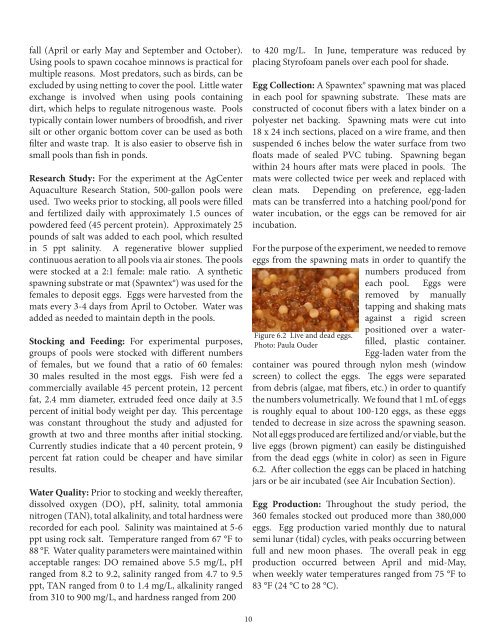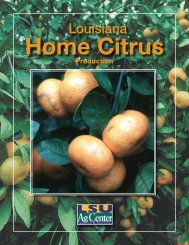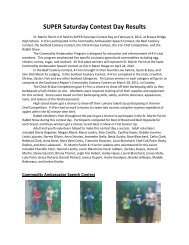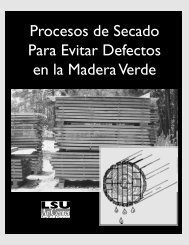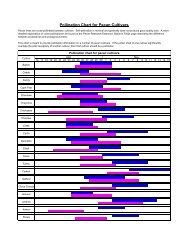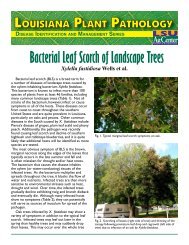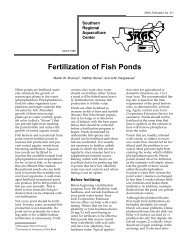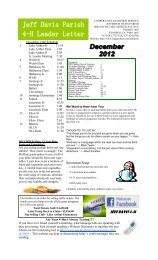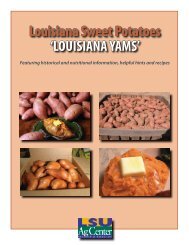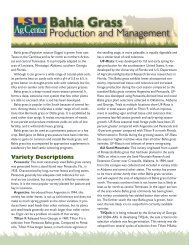Cocahoe Minnow - The LSU AgCenter
Cocahoe Minnow - The LSU AgCenter
Cocahoe Minnow - The LSU AgCenter
You also want an ePaper? Increase the reach of your titles
YUMPU automatically turns print PDFs into web optimized ePapers that Google loves.
fall (April or early May and September and October).<br />
Using pools to spawn cocahoe minnows is practical for<br />
multiple reasons. Most predators, such as birds, can be<br />
excluded by using netting to cover the pool. Little water<br />
exchange is involved when using pools containing<br />
dirt, which helps to regulate nitrogenous waste. Pools<br />
typically contain lower numbers of broodfish, and river<br />
silt or other organic bottom cover can be used as both<br />
filter and waste trap. It is also easier to observe fish in<br />
small pools than fish in ponds.<br />
Research Study: For the experiment at the <strong>AgCenter</strong><br />
Aquaculture Research Station, 500-gallon pools were<br />
used. Two weeks prior to stocking, all pools were filled<br />
and fertilized daily with approximately 1.5 ounces of<br />
powdered feed (45 percent protein). Approximately 25<br />
pounds of salt was added to each pool, which resulted<br />
in 5 ppt salinity. A regenerative blower supplied<br />
continuous aeration to all pools via air stones. <strong>The</strong> pools<br />
were stocked at a 2:1 female: male ratio. A synthetic<br />
spawning substrate or mat (Spawntex®) was used for the<br />
females to deposit eggs. Eggs were harvested from the<br />
mats every 3-4 days from April to October. Water was<br />
added as needed to maintain depth in the pools.<br />
Stocking and Feeding: For experimental purposes,<br />
groups of pools were stocked with different numbers<br />
of females, but we found that a ratio of 60 females:<br />
30 males resulted in the most eggs. Fish were fed a<br />
commercially available 45 percent protein, 12 percent<br />
fat, 2.4 mm diameter, extruded feed once daily at 3.5<br />
percent of initial body weight per day. This percentage<br />
was constant throughout the study and adjusted for<br />
growth at two and three months after initial stocking.<br />
Currently studies indicate that a 40 percent protein, 9<br />
percent fat ration could be cheaper and have similar<br />
results.<br />
Water Quality: Prior to stocking and weekly thereafter,<br />
dissolved oxygen (DO), pH, salinity, total ammonia<br />
nitrogen (TAN), total alkalinity, and total hardness were<br />
recorded for each pool. Salinity was maintained at 5-6<br />
ppt using rock salt. Temperature ranged from 67 °F to<br />
88 °F. Water quality parameters were maintained within<br />
acceptable ranges: DO remained above 5.5 mg/L, pH<br />
ranged from 8.2 to 9.2, salinity ranged from 4.7 to 9.5<br />
ppt, TAN ranged from 0 to 1.4 mg/L, alkalinity ranged<br />
from 310 to 900 mg/L, and hardness ranged from 200<br />
10<br />
to 420 mg/L. In June, temperature was reduced by<br />
placing Styrofoam panels over each pool for shade.<br />
Egg Collection: A Spawntex® spawning mat was placed<br />
in each pool for spawning substrate. <strong>The</strong>se mats are<br />
constructed of coconut fibers with a latex binder on a<br />
polyester net backing. Spawning mats were cut into<br />
18 x 24 inch sections, placed on a wire frame, and then<br />
suspended 6 inches below the water surface from two<br />
floats made of sealed PVC tubing. Spawning began<br />
within 24 hours after mats were placed in pools. <strong>The</strong><br />
mats were collected twice per week and replaced with<br />
clean mats. Depending on preference, egg-laden<br />
mats can be transferred into a hatching pool/pond for<br />
water incubation, or the eggs can be removed for air<br />
incubation.<br />
For the purpose of the experiment, we needed to remove<br />
eggs from the spawning mats in order to quantify the<br />
numbers produced from<br />
each pool. Eggs were<br />
removed by manually<br />
tapping and shaking mats<br />
against a rigid screen<br />
Figure 6.2 Live and dead eggs.<br />
Photo: Paula Ouder<br />
positioned over a waterfilled,<br />
plastic container.<br />
Egg-laden water from the<br />
container was poured through nylon mesh (window<br />
screen) to collect the eggs. <strong>The</strong> eggs were separated<br />
from debris (algae, mat fibers, etc.) in order to quantify<br />
the numbers volumetrically. We found that 1 mL of eggs<br />
is roughly equal to about 100-120 eggs, as these eggs<br />
tended to decrease in size across the spawning season.<br />
Not all eggs produced are fertilized and/or viable, but the<br />
live eggs (brown pigment) can easily be distinguished<br />
from the dead eggs (white in color) as seen in Figure<br />
6.2. After collection the eggs can be placed in hatching<br />
jars or be air incubated (see Air Incubation Section).<br />
Egg Production: Throughout the study period, the<br />
360 females stocked out produced more than 380,000<br />
eggs. Egg production varied monthly due to natural<br />
semi lunar (tidal) cycles, with peaks occurring between<br />
full and new moon phases. <strong>The</strong> overall peak in egg<br />
production occurred between April and mid-May,<br />
when weekly water temperatures ranged from 75 °F to<br />
83 °F (24 °C to 28 °C).


